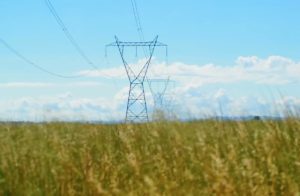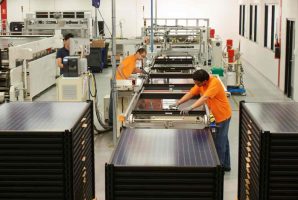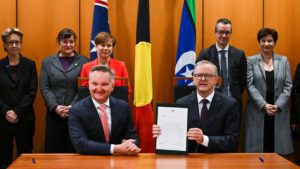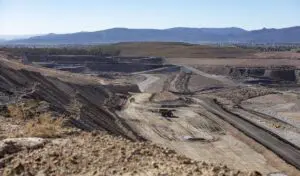It was yet another case of exquisite timing by Labor. On the very same day that US president Joe Biden unveiled sweeping initiatives to fast track emission cuts, and two new reports warned of the economic and environmental risks of Australia’s climate policy resting at a standstill, Labor leader Anthony Albanese – wearing what looked suspiciously like a hat borrowed from Barnaby Joyce – announced a cabinet re-shuffle and promised to do exactly that: Nothing.
Albanese likes to say “there is no way that a Labor government that I lead won’t take action on climate change.” But the double negative is hardly inspiring. What Albanese won’t say is what and how much he would do were he in government, and he is clearly too scared of the Murdoch media to give even a hint of increased ambition, or the suggestion of an interim target beyond the Morrison government’s plainly inadequate Paris commitments.
The highly respected Mark Butler, before being dumped from the climate portfolio, insisted that Labor’s interim targets – once it found the courage to announce them – will be based on the “science”.
This week, the scientists made clear what that would involve. At least a 70 per cent reduction by 2030 and zero emissions by 2035 if the goal is to try and limit global warming to 1.5°C. The Climate Council observed that doing nothing more than current policies would cost Australia $100 billion a year, or $2 billion a week. In the US John Kerry noted that “it is now cheaper to deal with the crisis of climate than to leave it.”
Those observations underline the point that any commitment less than what the science recommends is a failure, and environmentally and economically destructive. Labor might as well have the proverbial drover’s dog in the climate role if it doesn’t set a meaningful interim target. Or Joel Fitzgibbon.
Mainstream media wasn’t much help, being typically obsessed by the politics rather than the policy. After the initial excitement of a mid-term re-shuffle, the leading commentators seemed to be successfully corralled by Labor apparatchiks and urged to argue that this was actually a good thing, as new man Chris Bowen would bring a new perspective to the role, and a focus on “jobs”.
That line might even have been echoed by Coalition operatives, who still can’t believe that Labor is providing no opposition to its appallingly lacking climate and energy policy.
Not that the Coalition should be too cocky. To borrow a sporting analogy, any team still stuck at 0-0 well into the second half of the electoral cycle, even after the Opposition failed to come out of the dressing rooms, does not have much to boast about. But that’s what happens when Morrison insists on passing the ball to the LNP and the Liberal right wingers, only to have them kick the ball out of play while they and the ball-boy (Fitzgibbon) dig up the pitch in search of old fossils.
But such is the state of climate and energy policy in Australia.
At the far right, you have the Nationals, with the loud and insistent support of the Murdoch media, arguing for new coal fired generators, and Barnaby Joyce and Matt Canavan sprouting complete nonsense, such as blaming renewables for the failure of network cables in suburban Sydney.
Morrison, after Biden made clear he will take climate action seriously, declared that the political fight was over. This not only ignores the Coalition’s internal wars, but begs the question of what happened to the science. He then appointed new members to his emissions reduction advisory panel – both among the obstinate opponents of serious climate action.
Morrison has made it clear that Australia won’t be increasing its Paris commitment – Australia’s policy is decided only by “Straya”, he insists. He won’t commit to zero emissions by a certain date because he says he doesn’t know how to get there. As department officials revealed last week, he hasn’t even bothered to ask, but others – such as AEMO, the CSIRO, and ClimateWorks have laid out plans, which, as Biden’s team observes, will cost less than business-as-usual and create more jobs and economic growth.
And on Monday Morrison pulled out his old trick about arguing against positions that no one is proposing – in this case introducing a tax to reach net zero emissions. That is his defence for doing nothing. And the result is that the Coalition – after nearly eight years in office and more than likely to secure another term – doesn’t have any climate, energy or EV strategy beyond some wishful thinking about a “gas-led” transition.
Labor should be doing better, if only to hold the government to account and present a credible alternative. There is no federal politician better informed on climate and energy and the EV transition than Mark Butler, but apart from his efforts of trying to say the right thing, he wasn’t allowed to push for the right policy.
Labor now thinks that its 2018 commitments signed by Butler – 45 per cent emissions cuts, 50 per cent renewables and a 50 per cent share of EVs in new car sales – were too much. But the science now makes clear they are too little. Even the Coalition has embraced the idea of reaching 50 per cent renewables by 2030, or at least recognised it can’t stop Australia reaching that milestone, try as it might.
Which leaves Australia looking for federal political leaders with vision and clarity. It shouldn’t be too hard, because they clearly exist in South Australia, where the Liberal Party is pushing to reach “net 100 per cent renewables” by 2030, and 500 per cent by 2050, and NSW, where energy minister Matt Kean has turned the energy debate upside down and the right way up.
The Greens and independents likely Zali Steggall read and understand the science, and their position – long mocked as too radical in Australian political circles – seems barely different to the policies proposed by governments in the US, Europe and elsewhere. But The Greens and independents are not an alternative government, even if they have shown, in Coalition with Julia Gillard’s Labor, in the ACT, and in New Zealand, that they can work constructively and help deliver meaningful policies.
So we have to wait for Australia to be forced to move by the sheer weight of diplomatic pressure from Biden’s US, the threat of carbon tariffs in Europe, or – finally – the recognition of the massive opportunities for a renewable-rich country to transform its economy.
It’s up to Labor to create the political tension for that to happen. Bowen – ironically the architect of the tax policies that likely did cause Labor to lose the unlovable election – is said to be in favour of some of “green new deal”, but unless it is along the lines of that proposed by Biden, it won’t amount to much at all.
The dramatic transformation of Australia’s electricity grid show us what’s achievable, and key institutions have even developed a blueprint for that transition to continue. The overwhelming theme of the Biden administration is to “let the science speak”, and the scale of what his team is proposing should not be underestimated. Engineers, economists, environmentalists and investors are on board. Can it really be that hard for the mainstream political parties to seize the moment?










